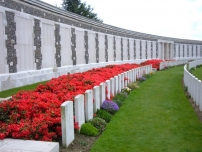| First Name: | Henry Harry | Last Name: | JOLLY | |
|---|---|---|---|---|
| Date of Death: | 20/09/1917 | Lived/Born In: | Earlsfield | |
| Rank: | Private | Unit: | West Riding10 | |
| Memorial Site: | Tyne Cot Memorial, Belgium | |||
Current Information:Enlisted-Camberwell
Third Battle of Ypres This was a campaign fought between July and November 1917 and is often referred to as the Battle of Passchendaele, a village to the north-east of Ypres which was finally captured in November. It was an attempt by the British to break out of the Ypres salient and capture the higher ground to the south and the east from which the enemy had been able to dominate the salient. It began well but two important factors weighed against them. First was the weather. The summer of 1917 turned out to be one of the the wettest on record and soon the battlefield was reduced to a morass of mud which made progress very difficult, if not impossible in places. The second was the defensive arrangements of concrete blockhouses and machine gun posts providing inter-locking fire that the Germans had constructed and which were extremely difficult and costly to counter. For 4 months this epic struggle continued by the end of which the salient had been greatly expanded in size but the vital break out had not been achieved. The Battle of the Menin Road. 20th-25th September, 1917 After the disappointing opening battles of the last day of July and the middle of August, when very little had been gained but at great cost in casualties, a new approach was adopted for the next offensive against the Gheluvelt plateau which began on 20th September and became known as the Battle of the Menin Road. The task was handed over to General Plumer, commander of the Second Army, a more cautious leader who, rather than try to drive as deep as possible into the German line, was an advocate of 'bite and hold' tactics with limited advances of no more than 1,500 yards, based on overwhelming firepower and exhaustive preparation. These new tactics, which were significantly aided by a period of warm, dry weather, worked well and September and early October saw a decisive phase of Third Ypres in which the British gained the upper hand. At the same time that Plumer’s Second Army were hammering away at the German defences on the Gheluvelt plateau, Fifth Army also attacked in the northern part of the Ypres salient and they too made gains. On 20th September, 1917, 23rd Division attacked on the Second Army front just to the south of the Menin road. The 11th West Yorkshire battalion led the attack by 69 Brigade and within half an hour they were at their objective, Inverness Copse on the Red Line after which the support battalions passed through to continue the attack. 10th West Riding and a company from the 8th Yorkshire battalion captured Northampton Farm but were then confronted by a string of 12 pill-boxes which resulted in many casualties. There were also casualties from more machine-gun emplacements on the Menin Road and the 9th Yorkshire battalion sustained heavy losses from pockets of the enemy in Inverness Copse which had been overlooked during the initial advance. But the attack continued and by mid morning they had reached their final objective and made contact with the Australians who had attacked on their left. Here they dug in and dealt with the counter-attacks launched against them in the afternoon. Among the casualties suffered by 69 Brigade on 20th September was Henry Jolly of 10th West Riding. |
||||
| « Back to Search Results | ||||
| If you think any of the information shown here is incorrect, Click Here to submit your amends and comments | ||||




